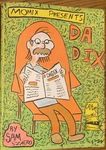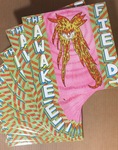
Fielder #3 is the comic book as meaning making machine. It is, literally, cover-to-cover comics – 38 pages worth – and, not only that, there are two front covers; so, in one sense, it is actually two comics that meet in the middle.
There is so much COMICS here. It could also be said to be a comic book about what a comic book can be. Like, “look at all these different ways to approach the medium: you can do this, and that – and this, and that; and if you combine this you can do that – and if you add that you can do this. And you could draw it this way, or that way, or a combination of the two… and/or…"
There are six distinct sections plus an editorial page.
1) A remixed version of the graphic novella, “Alla Prima” that had previously been published in an entirely different format, as a stand-alone work, in Italy. Here, in the pages of Fielder #3, this piece, which runs an extremely dense thirteen pages (and also takes up the lion’s share of the editorial page), is a fictionalized retelling of the story of two young American painters in Italy in the 1880s that serves as a nexus of art history, art theory and the American-European linkages that were so central to the work of Henry James.
2) An ample selection of the “You and Me” series – some of which have been posted online – which are part formal exercises, part deconstruction of gag cartooning, that work to strip down the form to its bare essentials so as to lay bare the underlying mechanics of the comics operations: of the basics of character; of panel to panel transitions; of timing and punchlines; compare and contrast; etc.
3) The inside front cover piece is a six-panel meditation on geometry
4) Flip it over and you’ve got Huizenga’s deconstructive send up of Sam Glanzman’s 1960’s Dell series, Kona, that begins on the inside front cover and tears through three pages filled with non-stop violent action at a frenetic pace, in “Bona.”
5) This is immediately followed, cheek to jowl, with Huizenga’s meta/deconstructive homage to E.C. Segar’s Popeye – which focuses specifically on Wimpy – which originally appeared as the introduction of the second volume of the ongoing Fantagraphics series collecting Segar's Popeye Sunday pages, "Wimpy & His Hamburgers," and that does double-duty as a workshop/class in both cartooning and the comics biz.
6) And, then, the pièce de résistance, the twelve page collaboration with Conrad Bakker, “Meta Modern Comics”, which deconstructs a particular comics-making project in a manner analogous to those those exploded diagrams showing all the parts of a car engine and drive shaft sort of floating in space in their proper positions with text explaining how everything works together to propel the car through space, only here the added dimension of time is added as the creative process runs back and forth over the internet and in person and, eventually, et voilà – the process becomes the project (or vice versa, if you prefer).
This description only scratches the surface of the comics complexities on hand here. Informative, educational, and, yes, entertaining. There is so much going on in these pages, that you will find yourself pausing and pondering again and again and as result you are likely to spend more time reading this single issue than many a graphic novel.
With that in mind, Fielder #3 has been printed in Canada and, like the first two, is magazine size. This issue feels good in the hands, providing a solid yet flexible heft while turning the pages – which are nicely printed on heavy, off white, flat stock in a variety of duotones featuring red, yellow, brown and green (along with a couple moments of brief full color).
It’s likely to be another year until the next issue, so take your time and savor this one.
RECOMMENDED



















